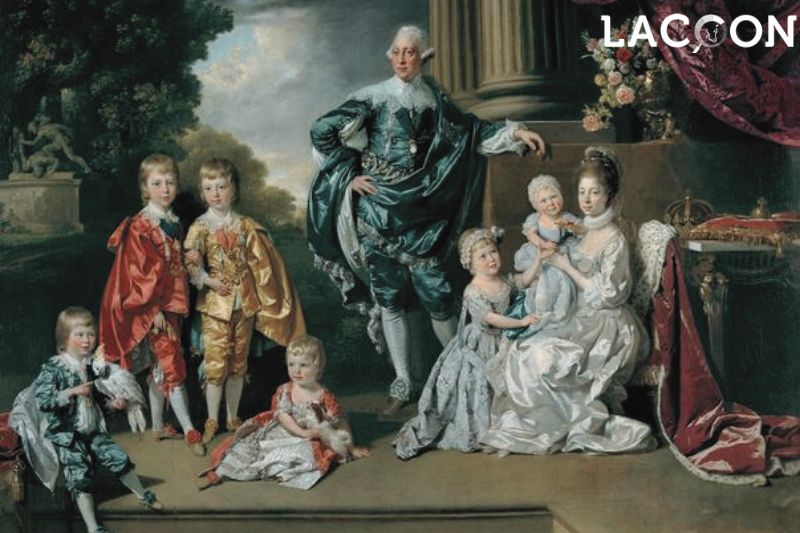The Netflix series Bridgerton, based on Julia Quinn’s novels, has captured the hearts of audiences worldwide with its Regency-era romance and intrigue.
Among the various characters in the show, King George III’s mysterious illness has piqued the interest of many viewers.
In this article, Lacoon delves into what’s wrong with King George III in Bridgerton, the different theories surrounding his condition, and how Bridgerton and its spin-off, Queen Charlotte, portray the monarch and his struggles.
King George III in Bridgerton – What’s Wrong With King George III In Bridgerton?

In Bridgerton seasons 1 and 2, King George III, played by James Fleet, appears only briefly and is mentioned infrequently.
This is because he is not meant to be a major character and partly because, by the time the show takes place, he was too ill to appear publicly.
The spin-off series, Queen Charlotte, features Corey Mylchreest portraying a younger King George III in his early 20s.
King George III’s brief appearances in Bridgerton are significant as they reveal details about Queen Charlotte’s character and motivations.
The dinner scene between Queen Charlotte and King George III in the first season provides an explanation for Queen Charlotte’s interest in Lady Whistledown.
It becomes clear that Charlotte needs a distraction from her husband’s deteriorating health, and Lady Whistledown serves that purpose.
The True Story of King George III’s Illness
King George III’s psychological issues, often reductively referred to as the “Madness of King George,” have been a subject of debate for years.
It is an undisputed fact that George was unable to continue ruling as a monarch by middle age.
This prompted his son, George IV, the Prince of Wales, to take over as Prince Regent. Due to George III’s instability and incoherency, he was kept out of the public eye to protect the monarchy’s image.
During his later years, King George III was confined and out of sight, much like in Bridgerton. However, unlike the show, Queen Charlotte had reportedly stopped dining with George and refused to be alone with him from 1804 onward.
By 1813, it is believed that Queen Charlotte had stopped seeing George altogether. The king experienced several extreme periods of ill health, long attributed to porphyria, and was eventually incarcerated in Kew for his own good.
After his final relapse in 1810, George never recovered and died in 1820.
King George III’s illness, as portrayed in Bridgerton, is based on historical accounts of the monarch.
These accounts describe symptoms such as convulsions, frothing at the mouth, incoherent rambling, bouts of depression, and later in life, the loss of hearing, vision, memory, and the ability to walk.
Following the death of Princess Amelia, George sank into a deep depression and never recovered. In 1811, he enacted the Regency Act, allowing his son to function as regent.
Queen Charlotte became George’s legal guardian, and his mental and physical health continued to deteriorate until his death in 1820.
Debate Surrounding King George III’s Illness

The exact cause of King George III’s “madness” has been a topic of debate among historians and physicians.
The prevailing theory for a long time was that George had porphyria, a rare liver disorder and that his exposure to arsenic contributed to worsening symptoms.
Although evidence for this theory is well-documented and still widely accepted, conflicting theories have emerged in recent years.
In the last decade, scientists, doctors, and historians have posited that King George III did not have porphyria but instead had a combination of bipolar disorder, chronic mania, and dementia.
Dr. Peter Garrard of St George’s, University of London, stated, “The porphyria theory is completely dead in the water. This was a psychiatric illness” (via BBC).
King George III’s Treatment as Depicted in Queen Charlotte
The spin-off series, Queen Charlotte, reveals the horrifying treatments King George III was subjected to in an attempt to “improve his condition.”
George was moved to Kew by force, under the care of court physicians and leading mental health expert Dr. Francis Willis.
Willis believed mental illness resulted from overexcitement and recommended restrictive, calming measures. These treatments included:
- Confinement in a straitjacket
- Skin treatment with arsenic powder to “draw unwanted humors out”
- Extreme fasting and purging
- Ice-cold baths to shock the illness from his body
- Denial of cutlery other than a spoon and only soft food at mealtimes
- Total isolation from family
- No permission to leave the house alone and confinement to the ground floor
Queen Charlotte and her daughter were also present at Kew during George’s treatments. While some of these treatments are shown in the spin-off series, others are left to the viewers’ imagination, arguably making them even worse.
Queen Charlotte’s Stance on King George’s Illness

The spin-off series, Queen Charlotte, leans towards modern theories regarding King George III’s illness.
It follows the more sympathetic perspective that the king struggled with debilitating psychological issues, such as hallucinations, absences, and bouts of mania.
Although George’s doctor initially suggests a more modern therapy style involving talking through his problems, this approach soon gives way to physical abuse that only worsens his condition.
Conclusion
Both Bridgerton and Queen Charlotte offer glimpses into the life of King George III and the mysterious illness that plagued him.
The debate surrounding the cause of his “madness” continues, with modern theories leaning towards a combination of bipolar disorder, chronic mania, and dementia.
These shows provide a window into the harsh treatments George endured and the impact of his illness on his family and the monarchy.
As viewers continue to enjoy the stories of Bridgerton and Queen Charlotte, they can better understand the struggles faced by one of history’s most enigmatic figures, King George III.





